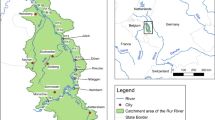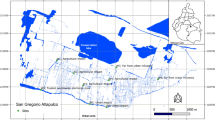Abstract
During the last decades, the global industrial production partly shifted from industrialized nations to emerging and developing countries. In these upcoming economies, the newly developed industrial centers are generally located in densely populated areas, resulting in the discharge of often only partially treated industrial and municipal wastewaters into the surface waters. There is a huge gap of knowledge about the composition of the complex organic pollutant mixtures occurring in such heavily impacted areas. Therefore, we applied a non-target screening to comprehensively assess river pollution in a large industrial area located in the megacity Jakarta. More than 100 structurally diverse organic contaminants were identified, some of which were reported here for the first time as environmental contaminants. The concentrations of paper manufacturing chemicals in river water—for example, of the endocrine-disrupting compound bisphenol A (50–8000 ng L−1)—were as high as in pure untreated paper industry wastewaters. The non-target screening approach is the adequate tool for the identification of water contaminants in the new global centers of industrial manufacturing—as the first crucial step towards the evaluation of as yet unrecognized environmental risks.


Similar content being viewed by others
Explore related subjects
Discover the latest articles and news from researchers in related subjects, suggested using machine learning.References
Botalova O, Schwarzbauer J, Frauenrath T, Dsikowitzky L (2009) Identification and chemical characterization of specific organic constituents of petrochemical effluents. Water Res 43:3797–3812
BPS (Badan Pusat Statistik) (2014) Population of Bekasi Regency based on gender. Statistic of Bekasi Regency 2014 and Statistic of Bekasi City 2014. http://bekasikab.bps.go.id
Brack W, Schirmer K, Erdinger L, Hollert H (2005) Effect-directed analysis of mutagens and ethoxyresorufin-O-deethylase inducers in aquatic sediments. Environ Toxicol Chem 24:2445–2458
Castillo M, Barceló D (2001) Characterisation of organic pollutants in textile wastewaters and landfill leachate by using toxicity-based fractionation methods followed by liquid and gas chromatography coupled to mass spectrometric detection. Anal Chim Acta 426:253–264
Castillo M, Alpendurada MF, Barceló D (1997) Characterization of organic pollutants in industrial effluents using liquid chromatography–atmospheric pressure chemical ionization–mass spectrometry. J Mass Spectrom 32:1100–1110
Castillo M, Barcelo D, Pereira AS, Neto FA (1999) Characterization of organic pollutants in industrial effluents by high-temperature gas chromatography–mass spectrometry. TrAC 18:26–36
Castillo M, Barceló D (1999) Identification of polar toxicants in industrial wastewaters using toxicity-based fractionation with liquid chromatography/mass spectrometry. Anal Chem 71:3769–3776
Cybriwsky R, Ford LR (2001) City profile: Jakarta. Cities 18:199–210
Dsikowitzky L, Schwarzbauer J, Littke R (2002) Distribution of polycyclic musks in water and particulate matter of the Lippe River (Germany). Organic Geochem 33:1747–1758
Dsikowitzky L, Schwarzbauer J (2013) Organic contaminants from industrial wastewaters: identification, toxicity and fate in the environment. In Pollutant Diseases, Remediation and Recycling (pp. 45-101). Springer
Dsikowitzky L, Botalova O, Illgut S, Bosowski S, Schwarzbauer J (2015) Identification of characteristic organic contaminants in wastewaters from modern paper production sites and subsequent tracing in a river. J Hazard Mater 300:254–262
Dsikowitzky L, Sträter M, Dwiyitno AF, Irianto HE, Schwarzbauer J (2016) First comprehensive screening of lipophilic organic contaminants in surface waters of the megacity Jakarta, Indonesia. Mar Pollut Bull 110:654–664
Dwiyitno D, Nordhaus L, Andarwulan I, Irianto N, H E, Lioe HN, Ariyani F, Kleinertz S, Schwarzbauer J (2016) Accumulation patterns of lipophilic organic contaminants in surface sediments and in economic important mussel and fish species from Jakarta Bay, Indonesia. Mar Pollut Bull 110:767–777
Eriksson E, Auffarth K, Eilersen AM, Henze M, Ledin A (2003) Household chemicals and personal care products as sources for xenobiotic organic compounds in grey wastewater. Water SA 29:135–146
Fares YR, Ikhwan M (2001) Conceptual modeling for Management of the Citarum/Ciliwung basins, Indonesia. J environ Hydrol 9: paper 10
Franke S, Hildebrandt S, Schwarzbauer J, Link M, Francke W (1995) Organic compounds as contaminants of the Elbe river and its tributaries. Fresen J Anal Chem 353:39–49
Fürhacker M, Scharf S, Weber H (2000) Bisphenol A: emissions from point sources. Chemosphere 41:751–756
GESTIS-Stoffdatenbank (2017) http://www.dguv.de/ifa%3B/gestis/gestis-stoffdatenbank, accessed in June 2017
Grigoriadou A, Schwarzbauer J (2011) Non-target screening of organic contaminants in sediments from the industrial coastal area of Kavala City (NE Greece). Water Air Soil Poll 214:623–643
Guedez AA, Püttmann W (2014) Printing ink and paper recycling sources of TMDD in wastewater and rivers. Sci Total Environ 468:671–676
Hernández F, Ibáñez M, Bade R, Bijlsma L, Sancho JV (2014) Investigation of pharmaceuticals and illicit drugs in waters by liquid chromatography-high-resolution mass spectrometry. TrAC 63:140–157
Hernández F, Ibáñez M, Portolés T, Cervera MI, Sancho JV, López FJ (2015) Advancing towards universal screening for organic pollutants in waters. J Hazard Mater 282:86–95
Horii Y, Reiner JL, Loganathan BG, Kumar KS, Sajwan K, Kannan K (2007) Occurrence and fate of polycyclic musks in wastewater treatment plants in Kentucky and Georgia, USA. Chemosphere 68:2011–2020
Jungclaus GA, Games LM, Hltes RA (1976) Identification of trace organic compounds in tire manufacturing plant wastewaters. Anal Chem 48:1894–1896
Jungclaus G, Avila V, Hites R (1978) Organic compounds in an industrial wastewater: a case study of their environmental impact. Environ Sci Technol 12:88–96
Klaschka U, von der Ohe PC, Bschorer A, Krezmer S, Sengl M, Letzel M (2013) Occurrences and potential risks of 16 fragrances in five German sewage treatment plants and their receiving waters. Environ Sci Pollut R 20:2456–2471
Körner W, Bolz U, Süßmuth W, Hiller G, Schuller W, Hanf V, Hagenmaier H (2000) Input/output balance of estrogenic active compounds in a major municipal sewage plant in Germany. Chemosphere 40:1131–1142
Liu R, Lin Y, Hu F, Liu R, Ruan T, Jiang G (2016) Observation of emerging photo-initiator additives in household environment and sewage sludge in China. Environ Sci Technol 50:97–104
Loos R, Hanke G, Umlauf G, Eisenreich SJ (2007) LC–MS–MS analysis and occurrence of octyl-and nonylphenol, their ethoxylates and their carboxylates in Belgian and Italian textile industry, waste water treatment plant effluents and surface waters. Chemosphere 66:690–699
Loos R, Gawlik BM, Locoro G, Rimaviciute E, Contini S, Bidoglio G (2009) EU-wide survey of polar organic persistent pollutants in European river waters. Environ Pollut 157:561–568
Lopez-Avila V, Hites RA (1980) Organic compounds in an industrial wastewater. Their transport into sediments. Environ Sci Technol 14:1382–1390
Marsh P (2012) The new industrial revolution: consumers, globalization and the end of mass production. Yale University Press, New Haven and London, United Kingdom, 311 pp
Mendum T, Stoler E, VanBenschoten H, Warner JC (2011) Concentration of bisphenol A in thermal paper. Green Chem Letters and Reviews 4:81–86
Ni HG, Lu FH, Luo XL, Tian HY, Zeng EY (2008) Occurrence, phase distribution, and mass loadings of benzothiazoles in riverine runoff of the Pearl River Delta, China. Environ Sci Technol 42:1892–1897
Oehlmann J, Schulte-Oehlmann U, Bachmann J, Oetken M, Lutz I, Kloas W, Ternes TA (2006) Bisphenol a induces superfeminization in the ramshorn snail Marisa Cornuarietis (Gastropoda: Prosobranchia) at environmentally relevant concentrations. Environ Health Persp 114:127–133
Oppenheimer J, Stephenson R, Burbano A, Liu L (2007) Characterizing the passage of personal care products through wastewater treatment processes. Water Environ Res 79:2564–2577
Pingali PL, Roger PA (1995) Impact of pesticide on farmer health and the rice environment. Kluwer academic publishers: Norwell, Massachusetts, USA and international Rice research institute (IRRI): Los Baños, Laguna, the Philippines, 664 pp.
Regnery J, Püttmann W (2010) Occurrence and fate of organophosphorus flame retardants and plasticizers in urban and remote surface waters in Germany. Water Res 44:4097–4104
Rosal R, Rodríguez A, Perdigón-Melón JA, Petre A, García-Calvo E et al (2010) Occurrence of emerging pollutants in urban wastewater and their removal through biological treatment followed by ozonation. Water Res 44:578–588
Scheurell M, Franke S, Hühnerfuss H (2007) Effect-directed analysis: a powerful tool for the surveillance of aquatic systems. Int J Environ An Ch 87:401–413
Schwarzbauer J, Littke R, Weigelt V (2000) Identification of specific organic contaminants for estimating the contribution of the Elbe river to the pollution of the German bight. Organic Geochem 31:1713–1731
Sigma Aldrich (2006) Sicherheitsdatenblatt Benzyl 2-naphthyl ether, S646210, http://www.sigmaaldrich.com, accessed in June 2017
Soares A, Guieysse B, Jefferson B, Cartmell E, Lester JN (2008) Nonylphenol in the environment: a critical review on occurrence, fate, toxicity and treatment in wastewaters. Environ Int 34:1033–1049
Spies RB, Andresen BD, Rice DW Jr (1987) Benzthiazoles in estuarine sediments as indicators of street runoff. Nature 327:697–699
Staples CA, Dome PB, Klecka GM, Oblock ST, Harris LR (1998) A review of the environmental fate, effects, and exposures of bisphenol a. Chemosphere 36:2149–2173
Sternbeck J, Österås AH, Woldergiorgis A (2012) REPORT screening of TPPO. In: TMDD and TCEP, three polar pollutants. Swedish Environmental Protection Agency, Report, 48pp
Sudaryanto A, Kunisue T, Kajiwara N, Iwata H, Adibroto TA, Hartono P, Tanabe S (2006) Specific accumulation of organochlorines in human breast milk from Indonesia: levels, distribution, accumulation kinetics and infant health risk. Environ Pollut 139:107–117
Takada H, Eganhouse RP (1998) Molecular markers of anthropogenic waste. In: Meyers RA (Ed.) encyclopedia of environmental analyses and remediation. Wiley: 2883-2940
Terasaki M, Fukazawa H, Tani Y, Makino M (2008) Organic pollutants in paper-recycling process water discharge areas: first detection and emission in aquatic environment. Environ Pollut 151:53–59
Toxnet (2017) Toxicology data network, US National Library of Medicine, data sheet Triphenylphsophine oxide, https://chem.nlm.nih.gov/chemidplus/rn/791-28-6, accessed in June 2017
UBA (Umweltbundesamt) Österreich (2009) Zulassungspflicht fürbesonders besorgniserregende Stoffe, Österreichische Kandidatenstoffe nach REACH 59 (3). Report REP-0241:102 pp. http://www.umweltbundesamt.at/
US EPA (Environmental Protection Agency) (2006) Inert Ingredient reassessment for 2,4,7,9-tetramethyl-5-decyn-4,7-diol (CAS Reg. No. 126–86-3) and 3,6-dimethyl-4-octyn-3,6-diol (CAS Reg. No. 78–66-0), https://www.epa.gov/sites/production/files/2015-04/documents/diols.pdf
Worawit W (2006) Characterization and fenton treatment of hazardous organic substances in Para rubber industrial wastewater in Southern Thailand. Ph.D. thesis, Chulalongkorn University, doi:123456789/8327
Acknowledgments
This study is part of the Indonesian-German SPICE Program (Science for the Protection of Indonesian Coastal Marine Ecosystems), funded by the BMBF, and supported institutionally by the Indonesian Research and Development Center for Marine and Fisheries Product Processing and Biotechnology. Special thanks go to Mrs. Yvonne Esser who supported the quantification of the organic contaminants.
Funding
This study is funded by the German Federal Ministry of Education and Research (BMBF, Grant No. 03F0641E).
Author information
Authors and Affiliations
Corresponding author
Additional information
Responsible editor: Ester Heath
Rights and permissions
About this article
Cite this article
Dsikowitzky, L., Hagemann, L., Dwiyitno et al. Complex organic pollutant mixtures originating from industrial and municipal emissions in surface waters of the megacity Jakarta—an example of a water pollution problem in emerging economies. Environ Sci Pollut Res 24, 27539–27552 (2017). https://doi.org/10.1007/s11356-017-0164-2
Received:
Accepted:
Published:
Issue Date:
DOI: https://doi.org/10.1007/s11356-017-0164-2




